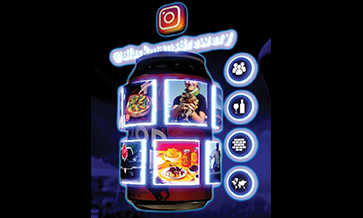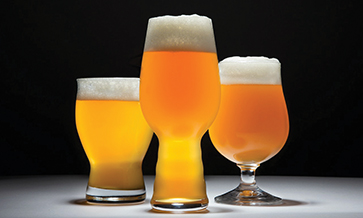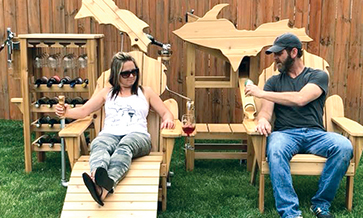Nitrogenation occurs when nitrogen gas (N2) is dissolved in the beer, usually in addition to carbon dioxide (CO2) gas. The ratio of the two gasses is typically around 70% N2 to 30% CO2. Although many beers are now served in nitrogenated form, nitrogenation is most closely associated with Irish stouts.
Nitrogen bubbles are more stable than CO2 bubbles, partially resulting from the fact that the surrounding air is mostly nitrogen as well. Because of the creamy head and the lower CO2 content, nitrogenated beers tend to have a creamy, smooth mouth feel, even when the beer below is technically light or even thin.
One way that nitrogenated beer can be distinguished from its normally carbonated counterpart is its creamy, persistent head of foam. Also, nitrogenated beer is notably less carbonated than most other beers and as a result has a less acidic flavour.
Nitrogenated beer was first mass marketed by Guinness during its 200th anniversary celebration in 1959. Guinness originally called its invention “easy serve” and despite 3 years of research and development at first only released it in England because of concerns that the technology was not yet perfected.
Serving technique
It was another 5 years until Guinness finally considered its new nitrogenated beer ready for release in Ireland in 1964. For Guinness, the advent of nitrogenated beer coincided with the popularisation of the use of metal kegs instead of wooden casks in the 1950s.
When Guinness decided to switch to kegged beer, which was far easier to handle and more stable in the marketplace, they looked to duplicate the soft texture of the original. Nitrogenation approximates the product of this traditional serving technique.
Although beer served traditionally through casks and under CO2 pressure has become the worldwide standard, nitrogenated beer remains an important factor thanks to brands such as Guinness and Boddington’s, who have developed, refined, and marketed nitrogenation.
Today, even craft brewers have begun to experiment with nitrogenation, although the technique requires very high nitrogen pressures in cellar tanks.
Creamy head
When a nitrogenated beer is first poured into a glass, it has a distinctive, homogenous, foamy texture. This texture is a result of the relative insolubility of nitrogen in beer (N2 is approximately 100 times less soluble in beer than CO2) combined with special dispensing technology.
In the case of nitrogenated beer served on draught, the special dispensing technology is a restrictor plate immediately prior to the faucet. This restrictor plate is perforated by a number of small holes, which in conjunction with the sudden pressure drop from one side of the plate to the other encourage extremely small nitrogen bubbles to form.
These small bubbles rise to the top of the glass much more slowly than CO2 bubbles and sometimes even flow downward (the downward-flowing bubbles are the ones closest to the side of the glass. They eventually work their way to the middle of the glass and rise to the top).
In the case of canned or bottled nitrogenated beer, the role of the restrictor plate is served by a device called a widget, which like the restrictor plate jets nitrogenated beer through several small holes.
After its initial foamy stage, a nitrogenated pour will gradually stratify into an attractive glass of beer topped with a dense, creamy head (a process that can take several minutes).
Customers often find the pulsating waves that form in the glass during the “settling” of the beer somewhat mesmerising, and the image of the settling pint has been used very effectively in advertising.
Word of caution
The almost imperceptibly small bubbles of N2 are much more persistent than larger CO2 bubbles, and the head that they form often lasts longer than the pint of beer itself.
However, nitrogen has this magical ability to absolutely destroy hop aroma, so putting a hoppy beer such as an IPA on nitro is just undoing all the work the brewer did by adding in all those hops!
Many brewers feel that nitrogenated dispense shreds notable character from beer, particularly degrading the crisp qualities of hop bitterness. Others argue that when brewers make beers intended from the outset to be served in nitrogenated form, it is possible to offset any negative effects while taking advantage of the formation of the creamy, long-lasting foam.
Enter NitroBrew
NitroBrew is a portable, simple, easy to use, plug-n-play equipment to nitrogenate any chilled beverage. A NitroBrew kit, made in the USA, consists of just three components, which together weigh less than 5 kg: a handsome kettle, a discreet charging station and a small, oil-free air compressor.
It captures free nitrogen from the air, thereby ensuring virtually nil maintenance and running costs on consumables.
The system is flexible and expandable: one compressor and charging station can serve up to six kettles. It occupies negligible space and gives flexibility to nitrogenate up to 350 ml per serving of a wide variety of beverages such as cocktails, coffees, beers, juices, clear soups, iced-teas, etc.
NitroBrew is suitable for bars, pubs, cafes and restaurants, apart from home use. If an outlet wishes to nitrogenate six beverages – such as stout, pale ale, cold brew coffee, Negroni, Manhattan and Espresso Martini – it will need six dedicated kegs, kegerators, taps and cylinders, each.
NitroBrew, on the other hand enables commercial establishments to nitrogenate a wide range of beverages without kegs. A single NitroBrew kit can nitrogenate multiple beverages thereby saving on space and costs required for keg based systems under the traditional system.
The entire process of setting up the NitroBrew kit takes under a minute without the use of tools, implements or an engineer. All you need to do is connect the compressor to the charging station via the included flexible hose pipe.
The precise balance of nitrogen and carbon-dioxide in a nitrogenated beer determines the nitro experience. NitroBrew takes out all the guesswork. You get a dependable mix of nitrogen and carbon dioxide with every pour in 30 seconds!
Mumbai-based Sandstorm Food and Beverages retails the NitroBrew kits. To know more about this patented system visit www.nitrobrew.in or email info@sandstormfnb.com.














